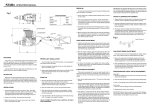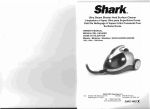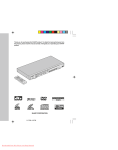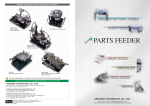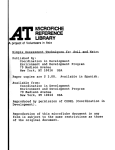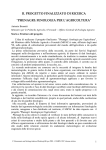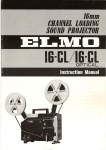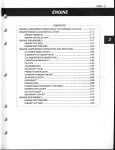Download MSU Extension Publication Archive Scroll down to
Transcript
MSU Extension Publication Archive Archive copy of publication, do not use for current recommendations. Up-to-date information about many topics can be obtained from your local Extension office. Pocket Pets – Hamsters Michigan State University Cooperative Extension Service 4-H Club Bulletin Ohio State University Issued April, 1980 18 pages The PDF file was provided courtesy of the Michigan State University Library Scroll down to view the publication. CO GE OF T M CHIGAN STA This manual is a reprint, with minor changes, from an Ohio State University Cooperative Extension Service manual on this subject. We are indebted to Ohio State University for granting permisSion to reprint this material. Michigan 4-H - Youth educational programs and all other Cooperative Extension programs are available to all without regard to race, color, or national origin . • Issued in furtherance of Cooperative Extension work, acts of May 8 and June 30, 1914, in cooperation with the U.S. Department of Agriculture. Gordon E. Guyer, Director, Coop er 9t ive Extension Service, Michigan State University, East Lansing, M! 48824. Price 40 cen ts MS U is an Affirmative Action/Equal Opp01-tunity Institution 0-12150 2P-SM-4:80-UP Mic higan State University Printing POCKET PETS Hamsters Hamsters can be fascinating company. They can ride around in your pocket, and they can be trained to do many tricks. For a little work (cleaning the cage and providing fresh food and water each day) and a little patience, you can have a healthy and active friend. 4-H 4-H projects are designed for youth groups by members of the Cooperative Extension Service. Information concerning projects is available to your group from your county Extension Service office. The 4-H Pledge is: I pledge: My HEAD to clearer thinking, My HEART to greater loyalty, My HANDS to larger service, and My HEALTH to better living, for My club, my community, My country, and my world. Project Requirements The purpose of the 4-H Pocket Pet project is to give you an opportunity to learn about and care for an animal. It will be your responsibility to feed, water, clean, and play with your pet. To learn how to care for your hamster, it is important to read this book. To answer the questions in this book, you will need to read it thoroughly and talk with your fellow members, your group leader, and any local resource people available. As a 4-H member, you will want to try to attend all of the meetings of your group; and you will want to take an interest and help plan activities for the group. Questions What is the name of your 4-H group? ----------------------------------------- Who is your 4-H leader?---------------------------------------------------Who is your Extension 4-H - Youth agent? ------------------------------------ Have you met your Extension 4-H - Youth agent? ------------------------------Where is the 4-H office located?------------------------------------------Do you know the 4-H Pledge? ________________________________________________ Word List: 1. 1. 2. 4. 5. Nocturnal Hi bernati on Pouches Estrous cycle Malocclusion In 1930, Professor Aronin, a scientist from Hebrew University, was studying and collecting small native animals of Syria. Syria is a country located north of Israel at the eastern end of the Mediterranean Sea. One day, after watching a hamster playing and burrowing in the sand, the scientist decided to dig into the sand to find out more about the hamster's living habits. Aronin had to tunnel eight feet before he found the mother and her nest. The hamster had 12 babies which he took back to the Hebrew University. When he arrived in Jerusalem, all but three of the hamsters had either died or escaped from the cage. The three remaining babies were well cared for and grew rapidly. It was soon discovered that two hamsters were females and one was a male. Within four months, one of the females gave birth to a litter of eight. More hamsters were raised. As the animals became more plentiful, they were used by scientists in laboratories. Some were sent to England in 1931 and to the United States in 1938. All hamsters that are now used as pets or laboratory animals are offspring of that original litter of eight. The name "hamster" is derived from the German word, hams tern , which means to hoard or to hi de. This describes what hamsters are like, as they store large amounts of food in their cheek pouch es. When cheek pouches are full, the hamsters appear to have mumps. This golden hamster has been alerted by a sudden n01-se . The golden or Syrian hamster (Cricetus auratus) is a rodent belonging to the family Cricetidae. Members of t his family are fou nd in Europe , Asia , - 2 - Africa, and America. The hamster is reddish-gold in color, with the stomach area nearl y white and with black markings on the head and cheeks. The eyes are black. The golden hamster has a short, stubby tail and well-developed cheek pouches in which it transports grain and other food. The adult animal is about' six inches long. A larger form, the black hamster, is about nine inches long and black, except for the feet, tail, nose, upper lip, and margin of the ears, which are covered with white hair. There is a reddish tinge behind the ears and near the tail. The black variety is found in Europe as far west as the Rhine River. It is more fierce than the Syrian hamster and has not been domesticated for laboratory use. In their native habitats, hamsters burrow into the ground and make one main tunnel with numerous side chambers in which food is stored. Hamsters are nocturnal animals, which means they sleep during the day and are active at night. In Europe, hamsters often cause heavy damage to crops . This tiny rodent will stuff its cheek pouches full of grain and hurry to its burrow, where, with a quick movement of its front paws, it empties the grain into a storage pile. Sometimes more than 100 pounds of grain have been found in the burrows. Consequently, the U. S. Department of Agriculture has issued the following warning: CAUTION Breeders of hamsters are cautioned to prevent the escape of any of these animals. Such release under favorable conditions might establish the hamster in the wild and thereby create a serious rodent problem, since they are destructive to growing crops, gardens, and oth er agricultural enterprises. Purchasers should be aware of the danger of escapes and make every effort to prevent the establishment of a wild colony. Questions Hamsters are rodents? True False What is the scientific name for hamster? ----------------------------------Where did hamsters originally come from? -------------------------------Who took the first hamsters to the Hebrew University? When? - - - - - - - - - - - - - List two reasons for raising hamsters today: 1. 2. - 3 - Selecting Your Hamster Purchase your hamster from a reliable source. It is wisest to select a healthy, young animal and train it yourself. Older animals that have been mistreated are often ill-tempered and may be difficult to handle . Select an animal between five and eight weeks old. Signs of good health are: soft, silken fur, a plump body, and prominent, bright eyes. Avoid selecting long or skinny hamsters. If at all possible, buy one that has been kept in a separate cage. Many pet stores ke ep animals all together. If selecting one from a group, you may end up with a pr egnant female. Take time in making your selection. Exami ne th e hams t er's ea r s, nose, eyes, and teeth. Sometimes hamsters bite, s o they should be ha ndled car efull y . The insides of the ears of a young hamster wi ll be covered with tiny white hai r s. As t he anima l becomes older , t hes e hairs graduall y di sappear until th e ears are hairless and s hiny. Be s ure t here are no patches of fur miss i ng, si nce th i s may be a sign of a dis ease called mange. Avoid animals with runny noses , watery eyes , or wet ta i l s . Some br eeders mark their hamsters by nicking the ears. The ears may al so be ni ck ed as the result of a hamster being in a fight . Regardles s of t he cause, 1nis plump~ bright-ey ed hamster would make a good pet. 1ne coat shows no signs of dis ease and the face shows a heal thy "nosy ~ " or inquisitive~ expression. t he ma r ks have no ill effect. It is generally considered best to buy one hamster at a t ime , s in ce two may fight. These animals are used to living by themselves and do not need companionship; therefore, if you only want a pet and do not plan on raising any litters, do not feel that more than one hamster is necessary. If you give it lots of love, it will be perfectly happy to live by itself. However, if you do buy a pair, be sure that you have two cages so they can be separated after t hey are eight weeks old. Males seem to make nicer pets due to their temperament. As they grO\lJ older, they remain tame and in a good mood. Females often have a tendency to grow less friendly, especially if they become pregnant; they are often snappy during pregnancy. - 4 - r I Ask the dealer to take the hamster from the cage and place it on a ta ble so you can watch it move around . Place your hand near the animal and see if it becomes nosy. Do not reach down from above and pick it up su ddenly since the hamster may become frightened and bi t e. After making your final decision , ca r ef ul ly take the hams ter home in a wire cage or box . Be su r e you have a cage ready. Questions Describe your hamster(s): - ----------------------------------- Do you have a male or female? - ---- What did you name it?- - -- - - Did you take a picture of your pet(s)? -----------------------------If so, place it here. Date- - - - - - Name - - - - - - -- -- - - --- Housing Hamsters should be kept in an environment with a temperature between 55 and 80° F. Adult animals can stand temperatures considerably lower, but newborn hamsters will die at lower temperatures. A temperature drop to 45° F. causes the animals to go into a state of hibernation. While they sleep, the body becomes rigid and the body temperature falls below normal . If this sho uld happen to your pet, do not become frightened and destroy it because you think your hamster 1S dead. The hamster may feel cold to the touch and lie still in your hand. Warm it gently with your body heat by carrying it around with you cupped in your hands. When it begins to move, feed it warm milk one drop at a time from a medicine dropper. Pick it up from time to time to warm it. When it revives and you return it to its cage, cover the cage with a heavy cloth. - 5 - Check into the prices of metal cages and compare the cost of materials, since it may be cheaper to buy a ready-made cage than to make one. A bird cage makes an excellent hamster cage. Hamsters should be kept in metal cages or wooden cages. Protect the lnsides of wooden cages with hardware cloth to prevent the animals from gnawinq throuqh. A surplus aquarium makes a very satisfactory cage. Cages may vary in size according to the number of animals to be kept together. A cage 12 inches wide by 15 inches long and 12 inches high will comfortably house one hamster. A cage 35 by 25 by 15 inches will accommodate eight to 10 animals. At least one side or the door of the cage should be made of hardware cloth to admit light and provide a means of exercise by climbing. The floor of the cage may be either the self-cleaning type or solid. In the self-cleaning type, the floor is made of No.6 hardware clo t h to allow the droppings to fall through onto a sloping floor. Along the lower edge of the floor is a trough for catching the droppings and liquid excrement. The slope of the floor should not be less than 30 degrees in order to allow material to slide from it into the trough. If the floor of the cage is solid, sawdust, wood shavings, ground corn cobs, peanut hulls, or other clean absorbent material should be used. Wood shavings can often be obtained f rom a lumber company. The absorbent material should be about one inch thick on the floor. Place aluminum foil under the cage to protect the shelf or table. It is lik ely that the hamster will use one corner of the cage for a bathroom. This corner should be cleaned every few days and new litter added. Once a week the cage should be scrubbed with soap and water. Wait until it's completely dry before putting your pet back in, because a wet cage can cause illness . Frequent disinfection with any of the standard creosol disinfectants will lesse n danger of disease and help eliminate odors. Good ventilat i on, plenty of sunlight, the presence of material to absorb liquid excrement, and frequent clea ning all work to reduce odors. A gravity water bottle can usually be purchased at stores that sell hamsters. It should be provided with a quarter-inch glass tube fou r to five inches long and hung on the outside of the cage. Re sure your pet always has plenty of fresh water. Provide your hamster with an empty co ttage cheese carton or a small box with a hole in the side and some tissues. Your hamster will shred the tissues and ma ke a nest in the box to sleep in or hide in when frightened. Questions Describe your cage: ------------------------------------------------------Where do you keep the cage?---------------------------------------------Describe your pet's waterer and feeder: ----------------------------------- - 6 - Feeding The simplest food for your pet is commercial hamster food which can be purchased at most pet stores or in the pet department in your local store. An adult hamster will require about a half-ounce of food each day. The natural food of the hamster consists of grains, seeds, and vegetables. A diet of corn, oats, or wheat mixed with some prepared dog food is also satisfactory. Place the dry feed in a dish that can be removed for cleaning. When the hamster is active in the evening and you feed it, it will begin to stuff the food into its cheek pouches. As soon as the pouches are full, the hamster will disappear to hide the food and quickly return to get another load. When you clean the cage, you will find this stored food. Remove any food that is spoiling, but otherwise replace it where you found it. r This hamster is eating a food biscuit and putting most of the food into its cheek pouches. You may also feed your hamster small amounts of lettuce, carrots, celery, and other vegetables and fruits. However, do not feed citrus fruits to your hamster, because citrus may cause stomach upset. Dry bread may also be fed to your pet. You may discover that your animal prefers certain vegetables, just as you prefer certain ones. When giving a new vegetable, be sure to give only a small amount until your pet becomes accustomed to it. Many of the above foods are used by your f ami ly and may be shared with your animal. Always remove and throwaway any of the green vegetables remalnlng in the cage at the end of the day. Your animal could become ill from eating decayed vegetables. The vitamin requirements of hamsters have had some study. Vitamins A, D, E, and K, and some of the B group are essential. Lack of vitamin E will result in death in four to 18 weeks. Most prepared hamster feed is we:l balanced and contai ns the essential vitamins and minerals. - 7 - • Just as you obtain your vitamins, hamsters obtain many of their vitamin and mineral requirements from the vegetables and fruits they eat. Foods which are deep green, deep yellow, or orange in color are very rich in vitamin A. The deeper the color, the more vitamin A a vegetable contains. Lettuce, broccoli, spinach, and carrots are just a few of the vegetables which are good sources of vitamin A. This vitamin is needed for growth, normal vision, and healthy condition of skin and other body surfaces. you. you. The other vitamins listed are just as important to your pet as they are to It is just as necessary for your pet to eat a balanced diet as it is for Water is essential for your hamster at all times. Lack of water will cause your hamster to lose weight and eventually die. However, when plenty of fresh greens are provided, the animal can get along with less water. Make sure the water bottle is filled frequently. The bottle should be washed, disinfected, and thoroughly rinsed at least once a week. If you give fresh milk to a pregnant female, be sure that you do not allow the milk to sour. Sour milk and spoiled food can cause your pet to have a stomach ache. Questions What do you feed your hamster? -------------------------------------------- What vitamin is provided by green foods? ----------------------------------What vegetable does your animal like best? ---------------------------------What is your favorite vegetable?------------------------------------------Handling Your hamster is really yours. It depends on you to feed and care for it. The more attention you give your hamster, the more fun you can have with it. You should have little trouble taming your hamster, but it must be handled frequently to remain tame. Hamsters will usually bite if they are awakened suddenly. Therefore, always be certain your pet is awake before you reach for it. The best way to tame it is to stroke its back quietly without trying to pick it up. When it gets used to your touch, gently slide your hand under its body and lift. Hold the hamster firmly in your hand and offer a treat. When your hamster learns to trust you, it will climb over your arm, legs, and shoulders and into your pockets. You will be able to lift it whenever you wish. Always remember, handle hamsters gently. If they are squeezed or grabbed - 8 - too tightly, they will struggle to escape. Never tease or frighten them. Also, always protect them from dogs and cats. Many times your friends will want to handle your hamster. You may want to demonstrate the correct way to pick it up and carry it. Always treat the animals with kindness and move slowly around them so they do not become nervous. PARTS OF A HAMSTER 1. 2. 3. 4. 5. Nose Eye Forehead Ear Nape of neck 6. 7. 8. 9. 10. Back Rump Tail Scrotum (male) Thigh 11 . 12. 13. 14. 15. Hind foot Belly Shoulder Forepaws Cheek pouch Tri cks Sometimes when you handle your hamster, put a piece of its favorite food in your hand so that it will get in the habit of coming to you. Whenever it does something that you like, give it a special treat (peanuts, cashews, or other nuts) . To get your pet to sit up, hold the special treat higher than its head. You may have to support your hamster with one hand. Teaching hamsters tricks takes a lot of time and patience. Don't ever try to teach more than one trick at a time. When one trick is finally learned, begin another one. Always repeat the trick it already knows while you are teaching a new trick. In time your hamster may stand and walk on its hind feet, climb a ladder, go down a slide, and turn in circles while standing (dancing). As you work with your hamster, think of various tricks you might wish to teach it. Read books about hamsters from your library and pet shop. Remembe r~ take plenty of time and patience , always reward your hamster with a special treat, and never mistreat your hamster. What tricks did you teach your pet(s)? ----------------------------------- - 9 - • Breeding If you decide to raise hamsters, be sure your female is at least eight weeks old before being bred. Many owners do not breed them until they are three months ol d. At this age, the hamster is be t ter able to stand the strain of raising a family. Remember~ the gestation (pregnancy) period for hamsters is only 16 days. A single female may give birth to from 30 to more than 100 young a year, and before the year is over, many of these young will be having young of their own. Decide how many cages and how much feed you would need if you went into the business of raising hamsters. Unless you are very well-equipped , it is best to keep the male and femal e separate and only breed them when you have a market for thei r young . The hams ter will breed t hroughout the year, but the most litters ar e produced between May and November. A fema 1e ra re ly produces young after th e -ag e of one year . The hamster on the le ft stands to reach a dangling cord. The hamster on the right leaves a hams ter ba ll. The female's estrous cycle (period of sexu al hea t) i s re peated every four days. Hamsters usually mate in t he evening. Since the f emale will often fight th e male, these directions should be followed: (1) For sev eral days , place the hamsters! cages close together so the animals can see each other. (2) Hamsters ar e nocturnal animals and prefer to mate at night. Observations in labo r atories have shown that most mating occurs between 9 and 10 p.m. Therefore, place the female into the male's cage one evening. (Never put the male into the female's cage; she may fight to protect her home and kill the male.) When handling the animals at this time, it is best to wear gloves. In case of a fight, you can separate the two easily and remove the female. (3) Mating should follow soon after the hamsters are placed together, and the female should be removed after an hour or two. (4) If the pair starts to fight and continues to do so, remove the female un til the next evening. You should try placing the female with the male each evenin g until they mate. Since the heat cycle is four days, mating - 10 - should occur withln a week after the first attempt. Usually, when the female is in heat, she will freeze as soon as she is placed in the male's cage and stare straight ahead with her tail and hindquarters slightly higher than her shoulders. (7) Make a record of the date when mating takes place. The young will be born 16 days later, usually at night. Mark the date on a calendar. If you have a scale that will weigh your female accuratel y , weigh her daily and keep a record. Her weight may nearl y double as the young develop within her body. The litter averages seven young, although as many as 12 to 13 babies may be born. The female does not require special care duri ng pregna ncy. It is wise not to handle her too muc h after the twelfth day; always be extra ca r efu l not t o drop her. You may wish to give her a sma ll dish of milk along with her regu l ar food. Keep this up until after the newb orn hams te r s are ab l e t o take car e of themselves. The f emale will build her own nest. Giv e her s cra ps of cloth, tis s ues, pa per , or cotton to li ne he r nest. Don't handl e or distur b t he mo th er f or seve ral days after her babies are bo r n. Don't even t ry to look at her nes t, s ince the mother migh t r esent t he scent f r om your hands. Someti mes a f ri gh t ened mother may kill and eat her litter, especially if i t i s her first. The fa mily should be left alone except for feeding the first nine days after birth . After this, you may resume cleaning t he cage and caring for your hamster as you did before her fa mil y arrived. Baby hamsters are born naked, blind, and very tiny. A litter of eight to 12 bab i es weighs less than one ounce. Hams te r s grow rapidly and, wi thin three days, the skin begins to darken and hair begins to appear. Since hamsters ar e This pregnant hOJn3 tel' shreds tissues to make a nest . f. ~ ~ '" ,} /.". @! .~ '* $>:",:-; born with teeth, they will begin to nibb l e on solid f ood when they are eight days old. At two weeks of age, each baby will weigh about one ounce and can be weaned (taken from the mother). The mother should be allowed to rest at least one week before remating. - 11 - • As the hamsters grow, it will become easier to determine which are the males and which are the females. The sexes should be separated before they are 35 days old. After weaning, handle the animals often so they become tame. Lift and hold them so you can examine the ir undersides. As they grow older, you should beg in to notice a difference in the shape of the rear of the body. Near the 35th day, you should see a definite difference. The testicles of the male, right at the base of the tail, give the body a tapering shape. The female is shorter and more rounded at the back and not as brightly colored as the male. Questions Did you raise a litter?- - - If so, how many were in the litter?- - - - - - - How old were the babies when you first saw them? ________________________ Describe what they looked like:~______~~_ _~~_~_~~_ _~ The gestation period for hamsters is ---- days. What did you do with your baby hamsters? _________________________ Health Care Your pet must be kO e pt in a dry cage and out of drafts. Hamsters can catch some human diseases such as the common cold. The animal's symptoms may be like yours when you have a cold--runny nose, sniffles, and a lack of activity. If this happens, clean the cage, put in new dry bedding, and make sure the cage is in a warm spot. You may want to put a newspaper over the cage to be certain it is out of a draft. Be sure the water is fresh, and give your pet a couple of drops of cod liver oil on a piece of bread. Clean the cage after your hamster has recovered. Be sure that wild mice or birds cannot get near your hamster's cage, as they often carry diseases and parasites. If you ever notice parasites such as fleas, lice, or other insects on your hamster , apply an insecticide that can be used on cats. Never use insecticides that are used on dogs. Always observe your pet in the evening. In the evening, a healthy hamster will run around in its cage, play on the wheel, look for food, clean its fur, climb on the cage wall, and carry its short tail erect. Listlessness, lack of appetite, dull eyes, and weight loss mean your hamster is either sick or becoming sick. Check its teeth to be sure they are not too long or broken, which causes the inability to eat. Remember, always give your pet some hard food such as rabbit pellets or dog biscuits, or put a piece of hardwood such as oak in the cage. - 12 - r Droppings also give clues as to how your pet feels. Loose, watery droppings may mean your hamster is eating too many fresh vegetables and fruits; hard, dry droppings indicate your pet is not eating enough of these foods. The condition known as cage paralysis is due to improper feeding (lack of vitamin D sources) and insufficient exercise. Symptoms include inactivity, the hamster1s inability to raise its head, and the manner in which the hamster crawls around (pushing its nose along the floor of the cage). If a hamster falls from a cage when the door is open or from a hand while being handled, the fall could be fatal. Females may die glvlng birth, due to malformation of the pelvis. This is common with runty females. Onlywell-developed, vigorous animals should be used for breeding. Hamste~s are curious creatures . This one is trying to find out if a watchband is edible. Make sure your pet can't nibble on something that might cause a stomach ache. Broken teeth resulting from falls or from biting the wire of the cage may cause inability to eat and consequent starvation. Unbroken teeth may be clipped so that they mesh evenly and enable the animal to eat. Malocclusion is a condition that frequently prevents the teeth from meeting properly and from wearing down evenly. It may be necessary to clip the teeth occasionally. Animals with this deformity should not be used for breeding, since the condition is often inherited. Too much growth of the teeth may be due to a lack of hard food and gnawing materials. Is your group planning a tour this year? Plan on visiting your local veterinarian. Find ou t what the doc t or does. Find out whether you would like this career. - 13 - • TEN RULES TO FOLLOW FOR RAISING HAMSTERS 1. 2. 3. 4. 5. 6. 7. 8. 9. 10. Clean the cage and equipment at least once a week. Disinfect the cage and equipment. Be sure the cage is dry after cleaning. Keep hamsters out of drafts. Feed your animal a balanced diet of dry and green foods. Remove all uneaten green food. Provide for clean fresh water. Provide adequate light and ventilation. Do not overhandle pregnant females and avoid disturbing the mother for at least nine days after the babies are born. Always check for parasites, such as lice and fleas; if you discover parasites, immediately treat your pet with an insecticide used for cats. Questions How often do you clean and disinfect your animal's pen and equipment? Did you have any disease problems this year? -------------------------------If so, what were they? ---------------------------------------------------- How would you treat your animal if you found fleas? This hamster stuffs the last little bite of food into its full cheek pouch. - 14 - HOW MUCH DOES YOUR PET COST YOU? Ex~enses 1. 2. 3. Cost of pet Cost of cage or building materials Cost of feed: Date Purchased Kind of Food 4. Cost of reference books: Title 5. Other expenses (toys, bedding, medicine, etc.): Item Total Expenses Income 1. Sales of animals: Nu mber Sol d Date Sold Total Income Difference between total expenses and total income - 15 - Amount Rece i ved MY PET (Write a short story about your pet) - 16 -




















